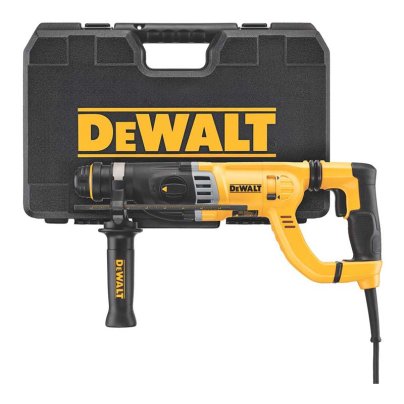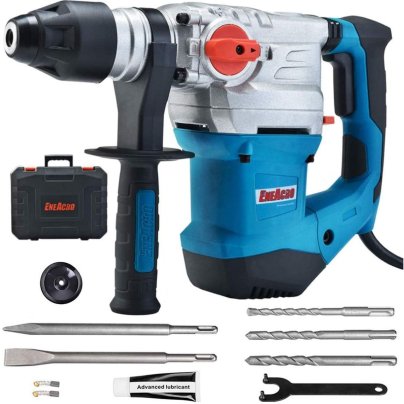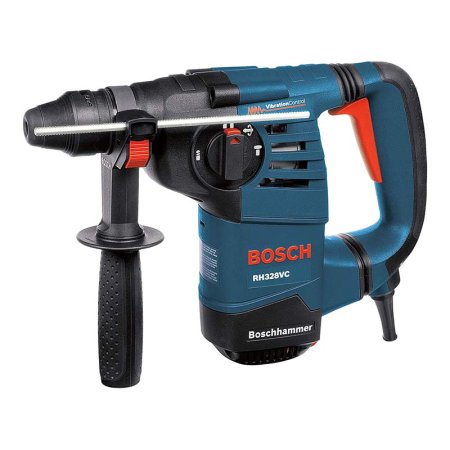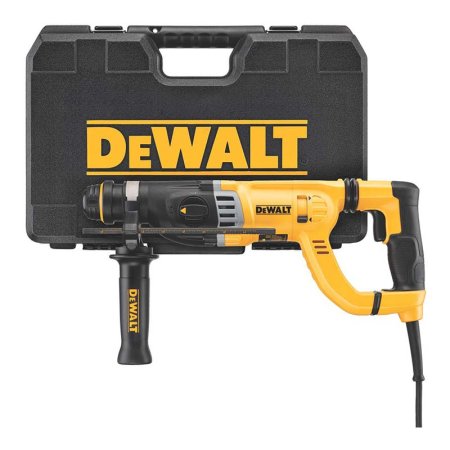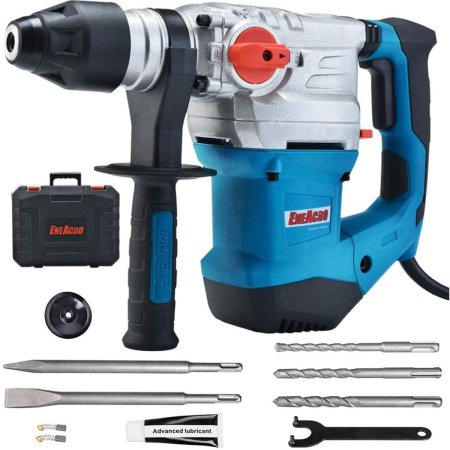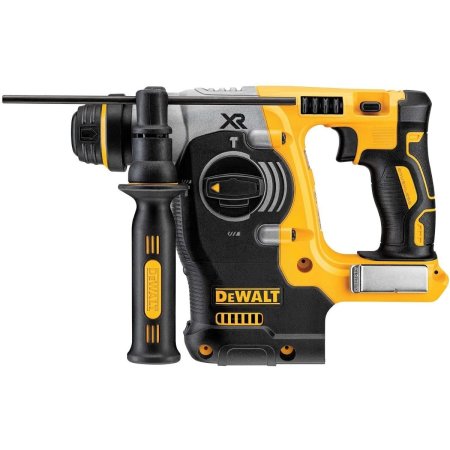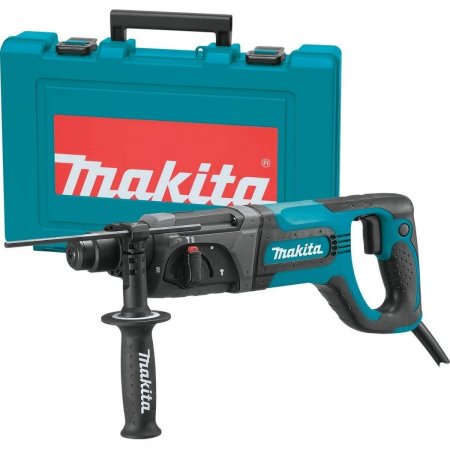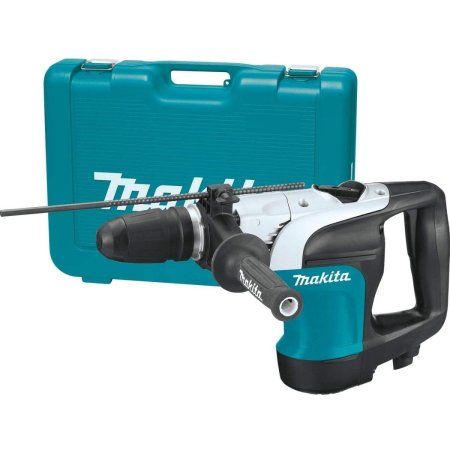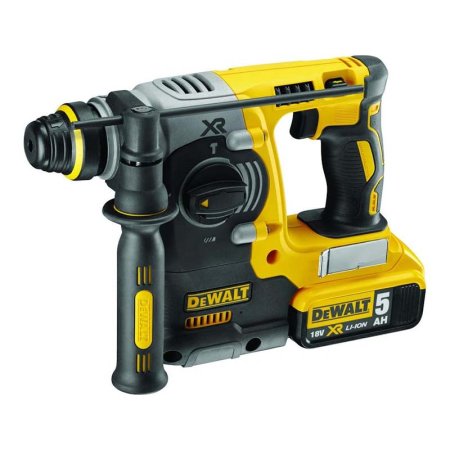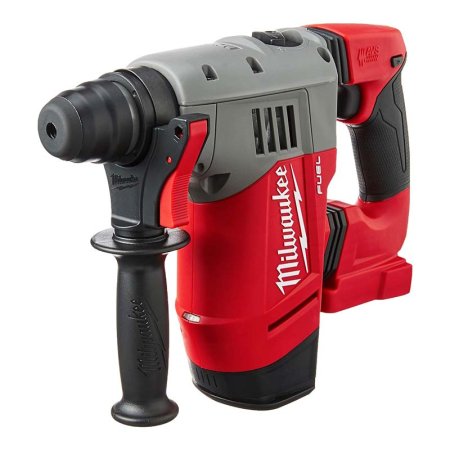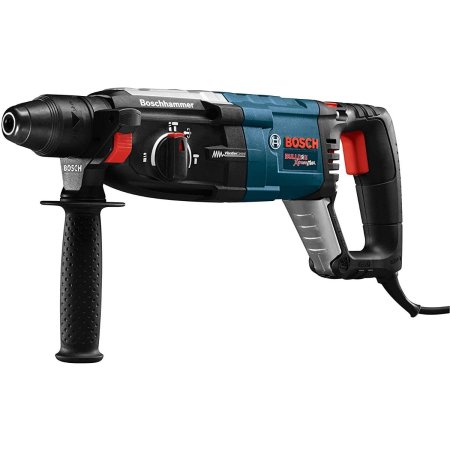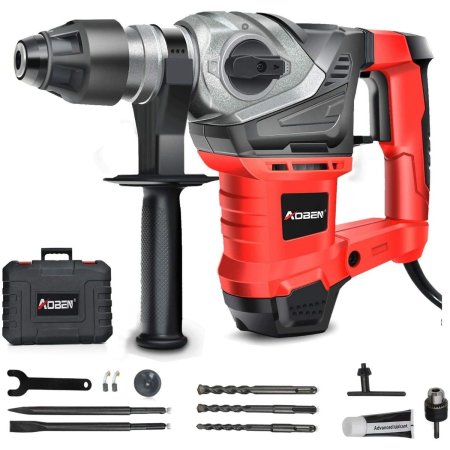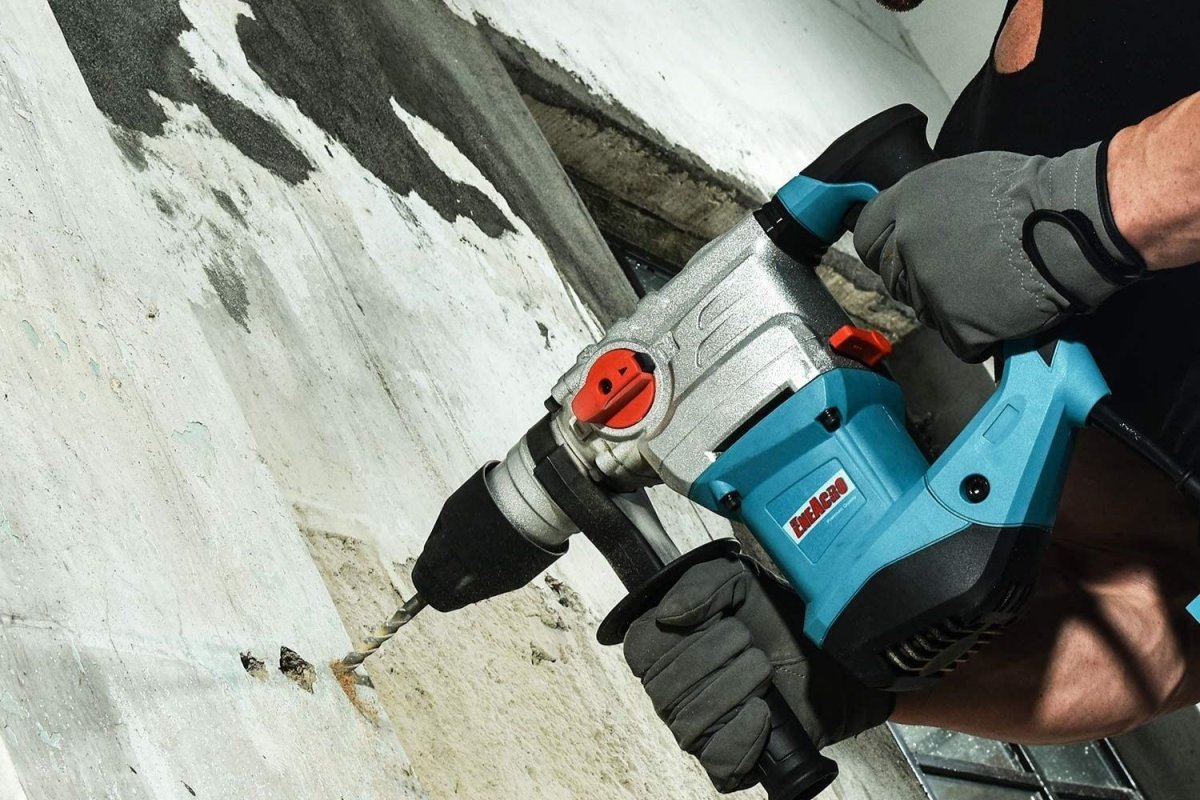
We may earn revenue from the products available on this page and participate in affiliate programs. Learn More ›
Standard hammer drills are powerful tools that can drill through a variety of tough materials, but even the best can’t make a hole beyond about ½ inch in diameter.
That’s when the rotary hammer drill takes over. These mighty tools have little trouble drilling through concrete slabs, concrete blocks, stone, and other tough materials. Drill bits that are a foot long or more are common. Flip a lever, and the same tool becomes a compact demolition hammer. It can strip tiles from walls, knock down brick walls, and break up asphalt.
A rotary hammer drill sounds like a fearsome tool, and some do have impressive capabilities. However, there also are very manageable models aimed at the DIY enthusiast. Keep reading to learn how to choose a rotary hammer drill for a variety of purposes, and check out the list of some of the best options on the market below.
- BEST OVERALL: Bosch RH328VC SDS-Plus 1⅛-Inch Corded Rotary Hammer
- RUNNER-UP: DeWalt 1⅛-Inch SDS Plus D-Handle Hammer Kit
- BEST BANG FOR THE BUCK: Eneacro 1¼-Inch Heavy Duty Rotary Hammer Drill
- BEST CORDLESS: DeWalt 20V MAX XR Rotary Hammer
- BEST FOR DIY REMODELERS: Makita HR2475 1-Inch SDS-Plus Rotary Hammer
- BEST SDS MAX: Makita HR4002 1-9/16-Inch SDS-Max Rotary Hammer
- BEST WITH DUST EXTRACTION: DeWalt DWH052 20V MAX Rotary Hammer & Dust Extraction
- BEST COMPACT: Milwaukee M18 Fuel 1⅛-Inch SDS-Plus Rotary Hammer
- BEST CONTROL: Bosch GBH2-28L SDS-Plus Bulldog Xtreme Rotary Hammer
- ALSO CONSIDER: Aoben 1¼-Inch SDS-Plus Rotary Hammer Drill
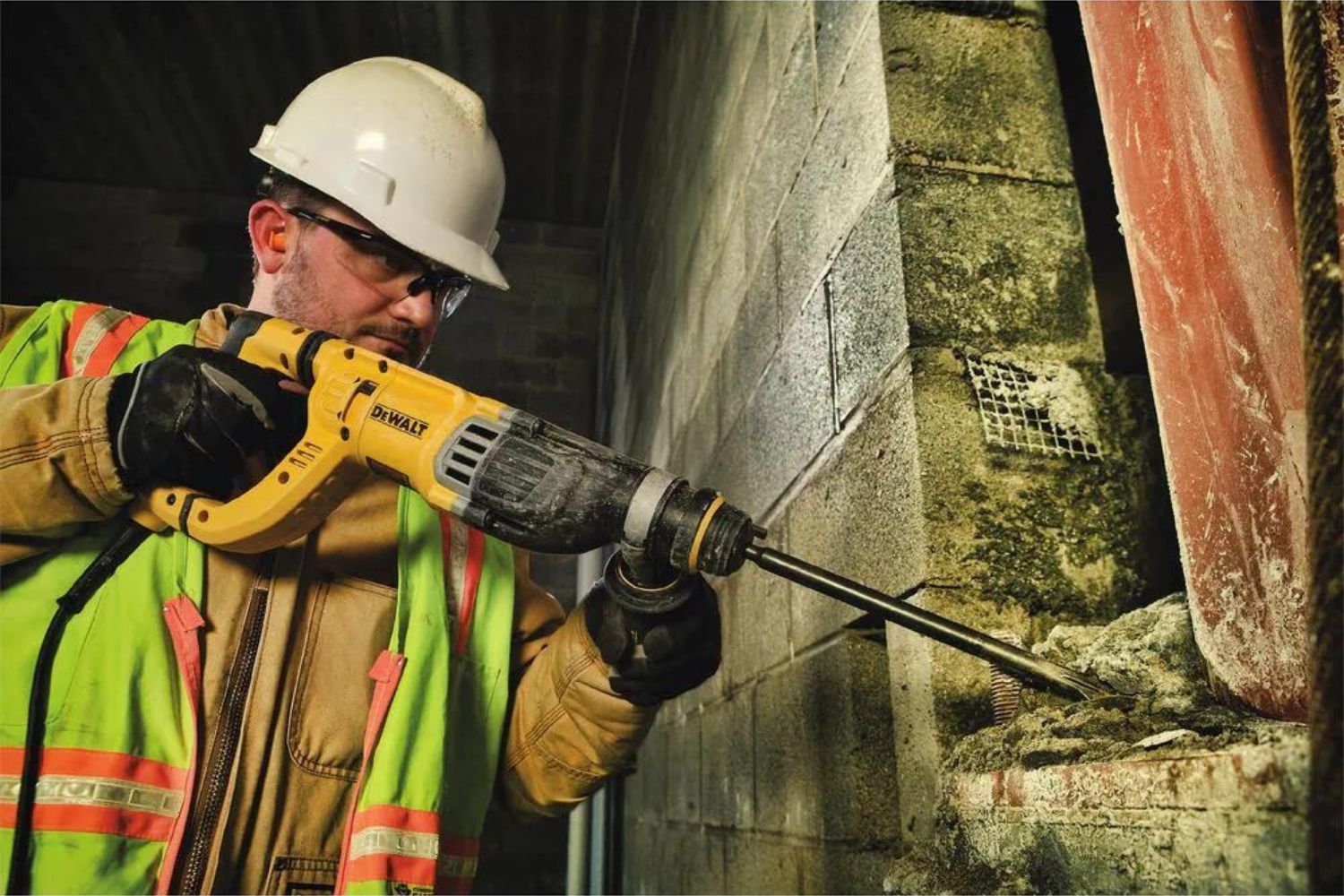
How We Chose the Best Rotary Hammer Drill
A great deal of research went into making our selections, which is conducted by experts with years of experience and in-depth technical knowledge. I am an engineer by trade and understand the key features in determining performance. I also have undertaken two complete house renovations using this type of tool, so I know first-hand how a rotary hammer drill functions.
I believe the most important factors to look for in rotary drills are available power, recommended maximum diameter, and impact energy. These largely determine the force that can be applied to a particular task and differentiate DIY tools from pro models.
I also have given consideration to the manufacturers’ reputations. Certain brands have long-standing reputations for reliability and durability. That said, I was careful not to overlook a bargain even if the maker is not one of the big names.
Our Top Picks
The following picks cover some of the best tools for both DIY and trade users. To make it easier to find the best rotary hammer drill for your needs, the products are shown in specific categories; we even included pros and cons for each.
Best Overall
Bosch RH328VC SDS-Plus 1⅛-Inch Corded Rotary Hammer
Pros
- Comparatively light and easy to handle; should not cause too much strain on the user
- Comes with vibration control and a variable-speed trigger built into the handle
- Comes with a depth stop and an auxiliary handle for added ease of use
- Compatible with Bosch’s Occupational Safety and Health Administration (OSHA)-standard dust extraction
Cons
- Heavy-duty competitors have a higher impact energy
Product Specs
- Drilling capacity: 1⅛ inches
- Impact energy: 2.4 foot-pounds (ft-lbs)
- Blows per minute (BPM): 4,000
With so many good models available, it is challenging to pick a single best rotary hammer drill. The corded Bosch SDS-Plus takes the top spot for its combination of user-friendly features, comparatively light weight, and competitive performance. The brand also has a well-earned reputation for long-term reliability.
Vibration control is built into the handle, which incorporates a 3-finger, variable speed trigger that’s easy to use with gloved hands. Mode selection is via a large, clear dial. There’s a handy depth gauge and the expected auxiliary handle. The chuck incorporates a clutch that reduces torque (and therefore the potential for injury) if the bit should jam.
Get the Bosch RH328VC rotary hammer drill at Amazon, Lowe’s, or The Home Depot.
Runner-up
DeWalt 1⅛-Inch SDS Plus D-Handle Hammer Kit
Pros
- Renowned DeWalt reliability; comes with vibration control and a clutch
- Compatible with DeWalt’s OSHA-standard dust extraction
- Traditional D-handle design allows room for gloved hands to steady while operating
Cons
- The 17½-inch length can sometimes be awkward
Product Specs
- Drilling capacity: 1⅛ inches
- Impact energy: 2.2 ft-lbs
- BPM: 5,350
DeWalt has an almost legendary reputation for durability, which is a key feature of tools intended for tough jobsite use like this corded rotary hammer kit. It features the traditional D-handle design that allows plenty of space for gloved hands. The length also allows the user to apply greater leverage than with compact models, which is particularly useful when chiseling or demolishing.
There is a useful depth gauge and a straightforward mode selection dial. The DeWalt rotary hammer drill also offers vibration suppression and an integrated clutch that minimizes torque-related injuries. It’s a tool that perhaps appeals more to the contractor than the DIY user, yet the price is very competitive.
Get the DeWalt SDS Plus rotary hammer drill at Amazon.
Best Bang for the Buck
Eneacro 1¼-Inch Heavy Duty Rotary Hammer Drill
Pros
- Easy-to-use controls; comes with dual handles for ample control when in use
- Built with an aluminum housing and a 13-amp motor for reliability and long-term use
- Everything required is in the case; includes a variety of accessories and tools
Cons
- At 18.1 pounds with accessories, it’s heavier than most other options on the market
Product Specs
- Drilling capacity: 1¼ inches
- Impact energy: 5.5 ft-lbs
- BPM: 4,200
Eneacro may not be one of the better-known tool manufacturers, but the brand’s corded rotary hammer drill is popular for good reason. It is a basic yet robust and capable performer that’s primarily aimed at the DIY user. An aluminum housing protects the heavy-duty 13-amp motor, which provides plenty of power for drilling and light demo work.
What really adds value is the accessory set. There are two chisels, three drill bits, lubricating grease, spare motor brushes, and a hard-shell case. Surprisingly for such a low-cost rotary hammer drill, it also has a safety clutch to reduce torque injuries and vibration damping.
Get the Eneacro rotary hammer drill at Amazon.
Best Cordless
DeWalt 20V MAX XR Rotary Hammer
Pros
- Versatile construction lends to use as a drill, hammer drill, or chipper
- Depth-stop rod lets users know when they have reached the appropriate depth
- Comes with user-friendly features, accessories, and a lightweight construction
- Works effectively on concrete, stone, brick, and block
Cons
- Our testers reported that this model had a long 3-hour charging time
- The accessory handle was not very sturdy
Product Specs
- Drilling capacity: 1 inch
- Impact energy: 1.54 ft-lbs (2.1 joules)
- BPM: 4,600
Those who want a lot of portability in their rotary hammer drill can rely on this cordless model from DeWalt. Perfect for
, concrete, stone, and block, this hammer drill comes with three operation modes: drill, hammer drill, and chipper. The depth-stop rod lets the user know when they have drilled to the desired depth.
For more user-friendliness, this DeWalt delivers 1.54 ft-lbs (2.1 joules) of impact energy. It has active vibration control and a brushless motor, an adjustable hook, a 360-degree side handle, and a rotating dial for adjusting the operating modes. Plus, this rotary hammer drill weighs only 6.4 pounds without the battery and won’t cause strain on the user during long-term use. The only downside to this option is that it only includes the tool and does not come with the required battery.
What our tester says: Glenda Taylor, Bob Vila staff writer and product tester, notes in The Best Cordless Hammer Drills that “it drilled through smoothly, and the ergonomic design allowed us to get a firm grip to maintain steady pressure. It drilled holes just as easily through cinder bricks. This model comes with a special chipping feature, so we inserted a masonry chip bit (shaped like a paddle) and used the rotary hammer to chip old grout off used bricks; it worked well and was simple to control.” Read our full review: DeWalt 20V MAX XR Rotary Hammer Get the DeWalt 20V MAX cordless rotary hammer at Amazon (tool only) or Acme Tools.
Best for Diy Remodelers
Makita HR2475 1-Inch SDS-Plus Rotary Hammer
Pros
- 7-amp motor is designed to provide a long service life
- Sequential impact timing delivers 50 percent faster drilling than many comparable models
- The rubberized D-shaped grip adds comfort and allows for precision while working
- Comes with 13 feet of cord for use at home as well as on a jobsite
Cons
- Limited vibration control; may be hard to hold properly while in use
Product Specs
- Drilling capacity: 1 inch
- Impact energy: 2 ft-lbs
- BPM: 4,500
The corded Makita is difficult to categorize. It has many of the features of pro-grade rotary hammer drills, though competitors offer higher performance. The D-handle design isn’t typical of DIY tools, yet it is priced to appeal to that type of user.
These factors make it an ideal choice for a DIYer taking on the kind of remodeling jobs that are beyond many entry-level drills. Sequential timing of hammer action and rotation maximizes the power available. The motor is designed for durability and minimal servicing requirements.
While this Makita rotary hammer drill does not offer active vibration control, it does have a soft-grip handle and a clutch to reduce torque if the bit jams.
Get the Makita HR2475 rotary hammer drill at Amazon.
Best Sds Max
Makita HR4002 1-9/16-Inch SDS-Max Rotary Hammer
Pros
- Heavy-duty performance with the help of a 10-amp motor and dual operation modes
- Physically no larger than SDS-Plus models; great for use in tight spaces and easy to transport
- Comes with a side handle, depth gauge, grease, and a carrying case
- No-hammer idle for increased tool life and reliability
Cons
- No drilling-only function; may not be ideal for some users’ preferences
- Vibration suppression could be improved
Product Specs
- Drilling capacity: 1-9/16 inches
- Impact energy: 4.6 ft-lbs
- BPM: 2,500
The corded Makita SDS-Max rotary hammer drill accepts 18-millimeter shank bits, which allows the use of larger diameter bits than SDS or SDS-Plus tools. A high-performance 10-amp motor provides the energy required to drive these bits efficiently. The two modes of drilling with hammer and hammer only underline the heavy-duty nature of this tool. Though the impact rate isn’t as high as many rivals, it’s the amount of force rather than the speed that is important for demolition work.
A torque-limiting clutch is fitted, and there’s a depth gauge. A rubberized soft-grip handle offers some reduction of vibration, though it’s surprising that there’s no active control. The price reflects the professional nature of the Makita SDS-Max rotary hammer drill. When compared to its direct rivals, it remains competitive.
Get the Makita HR4002 rotary hammer drill at Amazon or The Home Depot.
Best with Dust Extraction
DeWalt DWH052 20V MAX Rotary Hammer & Dust Extraction
Pros
- Brushless motor maximizes battery performance and performance time
- Active vibration control allows for steadiness and accuracy while preventing strain on the user
- Connector and hose for OSHA-standard dust extraction
Cons
- Bare tool; no batteries or additional accessories are included with purchase
- High amp hour (Ah) batteries are expensive
Product Specs
- Drilling capacity: 1 inch
- Impact energy: 1.5 ft-lbs
- BPM: 4,600
The DeWalt DWH052 rotary hammer drill is a high-quality cordless tool. The MAX name refers to the DeWalt batteries required as opposed to the SDS size. The drill takes standard 10-millimeter shank SDS bits.
The rotary hammer drill has all the features expected from DeWalt. Active vibration control reduces user fatigue, and the brushless motor makes efficient use of the available power. Mode selection is easy and a depth gauge is fitted.
This model also includes a dust shroud and hose that are compliant with OSHA workplace dust extraction regulations. It has a rotary fitting for free movement with a 1⅛-inch diameter, a size common to many other demolition tools.
Get the DeWalt DWH052 rotary hammer drill at Amazon, Lowe’s (tool only), or The Home Depot (tool only).
Best Compact
Milwaukee M18 Fuel 1⅛-Inch SDS-Plus Rotary Hammer
Pros
- 30 percent shorter than many comparable models on this list; fits in small spaces easily
- Powerful enough to be used by DIYers as well as pros; reaches up to 1,350 revolutions per minute (rpm)
- Weighs under 9 pounds with the battery; should not cause any fatigue for the user
Cons
- Expensive compared to other options on this list
- Does not come with a battery or charger
Product Specs
- Drilling capacity: 1⅛ inches
- Impact energy: 3.3 ft-lbs
- BPM: 5,000
Milwaukee has built a reputation for professional-grade tools that are durable and reliable. Their increasingly broad cordless range includes this impressive rotary hammer drill.
Unlike older-style models that have a mechanism, motor, and a D-handle all in a line, this cordless model has a much more compact design. The result is a tool that’s around 30 percent shorter, at under 13 inches from front to back. While drill or chisel bits still add to that length, it will work in confined spaces where few rivals will fit.
Despite the modest dimensions and lightweight construction, this Milwaukee rotary hammer drill is among the most powerful cordless SDS-Plus models available. However, it does come at a premium price and is sold as a bare tool, so the battery and charger are extra.
Get the Milwaukee rotary hammer drill at Amazon.
Best Control
Bosch GBH2-28L SDS-Plus Bulldog Xtreme Rotary Hammer
Pros
- Excellent power for the weight; comes with an 8.5-amp motor
- Efficient anti-kickback system stops the tool from rotating for safety
- 17-inch length and dual handles provide the user with a lot of control and comfort
Cons
- Not intended for heavy-duty use; may not be ideal for the jobsite
Product Specs
- Drilling capacity: 1⅛ inches
- Impact energy: 2.4 ft-lbs
- BPM: 5,100
With its D-handle and somewhat dated design, the corded Bosch SDS-Plus rotary hammer drill is easy to overlook. That would be unfortunate because it has a number of attractive features.
At just 6.9 pounds, it is among the lightest in its class, yet performance isn’t sacrificed. The 17-inch length gives good leverage and the handle provides plenty of room for a gloved hand. There is vibration control and an anti-kickback mechanism, which is Bosch’s term for the torque reduction many competitors offer.
All in all, it is a great all-rounder that would suit the serious DIY enthusiast and tradesperson looking for midrange performance at a competitive price.
Get the Bosch GBH2-28L rotary hammer drill at Amazon.
Also Consider
Aoben 1¼-Inch SDS-Plus Rotary Hammer Drill
Pros
- Powerful 13-amp motor can be used to drill through masonry and metal
- Comes with comprehensive accessory set, including drill bits, chisels, a chuck, grease, and motor brushes
- Features onboard vibration control for accuracy and comfort while in use
Cons
- Inconsistent build quality can result in breakdowns
- Very heavy compared to other options on the market
Product Specs
- Drilling capacity: 1¼ inches
- Impact energy: Not available
- BPM: 4,250
Those who are undecided about whether to buy a rotary hammer drill because they foresee limited use may want to consider the Aoben tool. It has the power to tackle jobs that are beyond the capabilities of a standard hammer drill at a budget-friendly price.
Figures for impact energy aren’t provided, but the 13-amp motor and 1¼-inch drill size give a good idea of its performance. With a weight just shy of 18 pounds, it is a bit of a beast, but it does offer vibration control.
This tool also comes with three drill bits, two chisels, a self-centering chuck, lubricating grease, and spare motor brushes. For those who need to do heavy-duty drilling and light demolition work on an occasional basis, it offers great value for money.
Get the Aoben rotary hammer drill at Amazon.
Jump to Our Top Picks
What to Consider When Choosing a Rotary Hammer Drill
The popularity of rotary hammer drills gives the potential buyer excellent variety, but options can lead to confusion. The key performance and physical aspects will dictate the best rotary hammer drill for your specific needs, and ensure you obtain maximum value from your purchase.
Type
Before considering the various technical aspects of rotary hammer drills, it’s important to know whether a corded or cordless model is best for your needs. Cordless models dominate the market for standard hammer drills, but it’s not quite so clear cut when it comes to rotary hammer drills.
Battery power is clearly the convenient option, but rotary hammer drills are power-hungry tools. The 18- or 20-volt battery used for standard drill/drivers, and rated for 1.5- or 2.0-amp hours, would offer very restricted runtimes. There usually are 3- or 4-Ah versions provided, but a spare battery is something of a necessity for those who want reliable continuous operation. An extra battery adds a substantial amount to the price, so a cordless rotary hammer drill often ends up being significantly more expensive than a corded model.
It’s worth mentioning that “bare tools” often seem like a great value, but they come without a battery or charger. If you already have other cordless tools from that manufacturer and the equipment is compatible, then you can save money by buying a bare tool. However, always check the specifications carefully before purchasing.
While cords can be inconvenient, and most of the time an extension cable would be required, they do provide consistent power for all-day working. As a result, around half of the best rotary hammer drills available are corded.
Power
Corded tools are rated by the amps that the motor uses. Rotary hammer drills tend to be as low as 8 amps and increase from there. The most powerful models are 13 or 14 amps. While 15 amps is a theoretical maximum (the most a standard outlet can supply), most manufacturers allow a margin that reduces the chances of a breaker tripping if there’s a power surge.
Cordless tools are rated by voltage, and range from 18 to 36 volts. While the rating shows the maximum power available, it’s also important to consider the amp hours of the battery (or batteries). Amp hours can be compared to the amount of gas in the tank. For example, a 4.0-Ah battery will run twice as long as a 2.0-Ah battery. While this may not have a major impact on DIY users, professionals who want to maximize runtimes want the highest Ah batteries available.
Performance
Most hammer drills give a figure for rpm, but rotational speed isn’t very important for rotary hammer drills. Some manufacturers provide it, but many do not. Instead, the majority rate the tool’s capabilities by giving a maximum hole diameter. Sometimes two are given, one for a solid drill bit, the other for a core bit (often used to bore holes for pipework).
The other important performance figure is the impact energy, effectively the power of the hammer action. This is often given as foot-pounds but sometimes as joules (J), which is the international system for measuring energy: 1 foot-pound = 1.356 joules.
BPM or impacts per minute (IPM) are frequently quoted. It’s the speed of the hammer action. A faster speed can be assumed to mean more aggressive performance, but actual impact energy is a more accurate measure.
Chuck
Most rotary hammer drills use an SDS chuck. These do not open and close like a standard three-jaw chuck. They have a sliding sleeve and a mechanism that clamps onto slots in the drill bit or chisel. It’s a very positive locking method with no chance of the bit slipping.
There are two sizes. SDS and SDS-Plus have a 10-millimeter shank. SDS Max has an 18-millimeter shank. While SDS bits will fit SDS-Plus tools, they will not fit SDS Max or vice versa, so it’s important to buy the right size bits.
There is an alternative on some hammer drills called a spline chuck. The bits have splines that lock them in place rather than slots. Spline chucks are much less common, and bits are not interchangeable with SDS.
Operation Modes
One of the reasons rotary hammer drills have become so popular is their versatility, with three distinct operating modes available.
The first two are much like what’s found on any hammer drill. It can be used as an ordinary drill, which simply rotates. Operating a lever or switch adds a percussive hammer action. This is much stronger on a rotary hammer drill than on a standard hammer drill.
The third mode disengages the rotary action and the tool works entirely as a powerful hammer, to which chisels of different widths can be fitted. Broad ones can make short work of removing tiles from walls or floors. Narrower and pointed chisels can be used for demolition work, including breaking up concrete slabs or asphalt.
Design and Ergonomics
A rotary hammer drill can be quite a bulky tool, but they are usually well balanced. Handles are open to allow for use with gloved hands. A large trigger also helps make the tool easier to use. Rubberized areas increase comfort and provide a secure grip.
An auxiliary handle that can rotate 360 degrees is usually provided at the front, allowing it to be moved to where it offers the best additional support. A rotary hammer can generate a lot of torque, so the additional handle helps keep it under control. Not using it can risk a nasty wrist injury.
Given that these tools have a powerful hammer action, it should be no surprise that they vibrate. This can quickly prove tiring for the operator. Better models have vibration control, generally some kind of shock absorber between the main body and the handle.
Attachments and Accessories
The main accessories for rotary hammer drills are the variety of SDS drills and chisels already mentioned above. These usually need to be purchased separately, though some tools include them. Many models have a handy depth gauge for use when drilling.
Rotary hammer drills often kick up a lot of dust, some of which has been linked to lung and kidney diseases. Even though some of the better rotary hammer drills incorporate dust ports that can be used in conjunction with other extraction equipment, always wear respiratory protection while using a rotary hammer drill. While this is a matter of personal choice for the DIY user, OSHA now has rules concerning workplace exposure, so it could well be a necessity for the professional.
FAQs
The article above contains a lot of valuable information that explains the technical aspects of these tools and can help you choose the best rotary hammer drill for your needs. However, during our research we found a number of common questions that are of concern to potential buyers. The following section addresses those questions.
Q. What’s the difference between a rotary hammer and a demolition hammer?
Generally speaking, a demolition hammer is even more powerful than a rotary hammer. It is focused on demolition and does not have a drill function.
Q. What’s the difference between a rotary hammer drill and an SDS drill?
Largely they are the same thing. SDS describes the type of chuck. These are SDS, SDS-Plus, or SDS Max. The majority of rotary hammer drills are fitted with one of these, and a few use what’s called a spline chuck instead.
Q. How long does a rotary hammer drill last on average?
It is impossible to say how long a rotary hammer drill will last, because it is dependent on the amount of use it gets and how hard it works. For light DIY use, a rotary hammer can last many years. Used every day in a tough job site environment, then it may last perhaps 2 or 3 years.
Q. How do I maintain my rotary hammer drill?
Rotary hammer drills are rugged tools that don’t need much maintenance. Some need periodic lubrication of the hammer mechanism, though others are sealed. Those with brush motors will eventually need to have the brushes replaced. On average this is required every 7,500 hours. Check the manufacturer’s instructions for a specific tool’s maintenance requirements.
Q. What does SDS mean?
Some say SDS means Slotted Drive Shaft. However Bosch, who invented it, calls it the Slotted Drive System.
Q. What does 1-inch SDS mean?
The SDS dimension is the maximum recommended drilling diameter in concrete, though the actual maximum will depend on material. So 1-inch SDS means that the rotary hammer drill in question is capable of drilling a maximum 1-inch diameter hole. The biggest generally available is 1 9/16-inch diameter.
Q. Can I use an SDS drill bit in a regular drill?
No. A regular drill probably doesn’t have the power to use an SDS drill bit efficiently, but the main reason is that the regular chuck won’t hold them securely. Using them would be unsafe.

